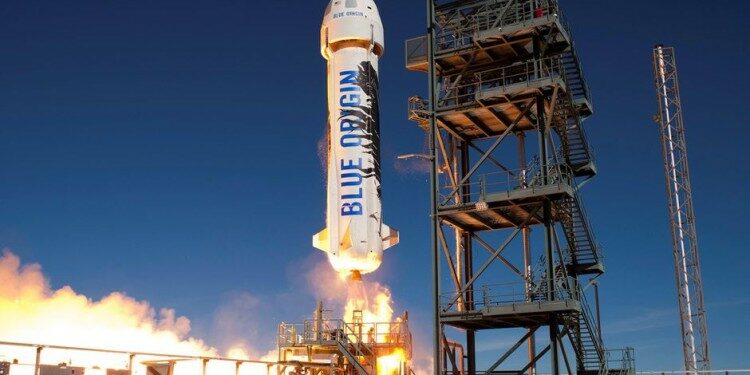In news
Recently, Amazon founder and billionaire Jeff Bezos’s space company called Blue Origin concluded the online auction for the first seat on New Shephard, a rocket system meant to take tourists to space
Key updates
- The winning bidder will get to fly aboard New Shephard along with Bezos and his brother, when it takes its first human flight on July 20
- July 20 marks the 52nd anniversary of Neil Armstrong and Buzz Aldrin’s moon landing.
About New Shephard
- It is a vertical-takeoff, vertical-landing (VTVL), crew-rated suborbital launch vehicle that is being developed by Blue Origin as a commercial system for suborbital space tourism
- Its name makes reference to the first American astronaut in space, Alan Shepard, one of the original NASA Mercury Seven astronauts, who ascended to space on a suborbital trajectory similar to that planned for New Shepard
- It offers flights to space over 100 km above the Earth and accommodation for payloads.
- It is a rocket system that has been designed to take astronauts and research payloads past the Karman line, the internationally recognized boundary of space.
- The idea is to provide easier and more cost-effective access to space meant for purposes such as academic research, corporate technology development and entrepreneurial ventures among others.
- Apart from its academic and research-oriented goal, New Shephard will also allow space tourists to experience microgravity by taking them 100 km above the Earth
- Prototype engine and vehicle flights began in 2006, while full-scale engine development started in the early 2010s and was complete by 2015.
- Uncrewed flight testing of the complete New Shepard vehicle (propulsion module and space capsule) began in 2015.
- In 2018, Blue Origin was one of the ten companies selected by NASA to conduct studies and advance technologies to collect, process and use space-based resources for missions to the Moon and Mars
- New Shephard completed its seventh test launch successfully in October 2020 when it took off from Texas.
How does this rocket system work?
- The rocket system consists of two parts, the cabin or capsule and the rocket or the booster.
- The cabin can accommodate experiments from small Mini Payloads up to 100 kg.
- As per Blue Origin, the Mini Payloads provide easier space access to students, who are part of educational institutions that are developing their own space programs
- Its cabin is designed for six people and sits atop a 60 feet tall rocket and separates from it before crossing the Karman line, after which both vehicles fall back to the Earth. All the six seats in the capsule are meant for passengers, each of whom get their own window seat. The capsule is fully autonomous and does not require a pilot.
- This system is a fully reusable, vertical takeoff and vertical landing space vehicle that accelerates for about 2.5 minutes before the engine cuts off.
- After separating from the booster, the capsule free falls in space, while the booster performs an autonomously controlled vertical landing back to Earth. The capsule, on the other hand, lands back with the help of parachutes.
Karman line
- It is an attempt to define a boundary between Earth’s atmosphere and outer space, which is important for legal and regulatory purposes
- The Fédération Aéronautique Internationale (FAI), an international standard-setting and record-keeping body for aeronautics and astronautics, defines the Kármán line as the altitude of 100 kilometres (62 miles; 330,000 feet) above Earth’s mean sea level.
- The Kármán line is named after Theodore von Kármán (1881–1963), a Hungarian American engineer and physicist who was active in aeronautics and astronautics.

- He was the first person to determine the altitude at which the atmosphere becomes too thin to support aeronautical flight, which Kármán calculated as 83.6 km (51.9 miles).
- A vehicle above this altitude would have to travel faster than orbital velocity to derive sufficient aerodynamic lift to support itself.
What is Space tourism?
It seeks to give laypeople the ability to go to space for recreational, leisure or business purposes. The idea is to make space more accessible to those individuals who are not astronauts and want to go to space for non-scientific purposes.
Instances of Space tourism
- According to a report published by the Congressional Research Service (CRS) the concept of space tourism is “fairly new”.
- The report mentions that in 1997, the private company Space Adventures was founded to offer “bookable space-related adventures”.
- In fact, Space Adventures is the only private company to send paying customers to orbital space so far, the report says.
- In 2004, test pilot Mike Melville became the first private astronaut to fly beyond the Karman Line.
- Adventures’ customer Dennis Tito became the first space tourist in 2001.
- Apart from Blue Origin, Richard Branson’s Virgin Galactic is also expected to begin space flights meant for space tourists this year.
- Elon Musk’s SpaceX is also working on sending tourists to space.
















